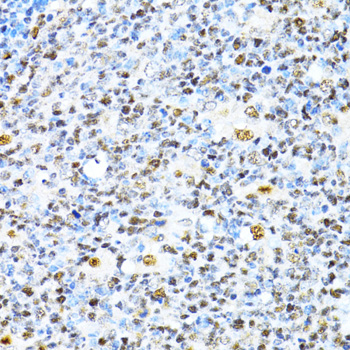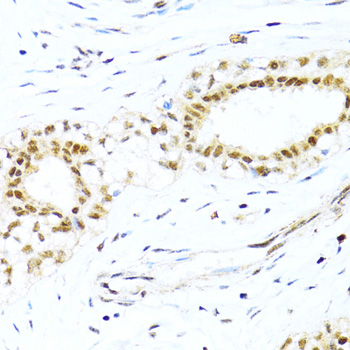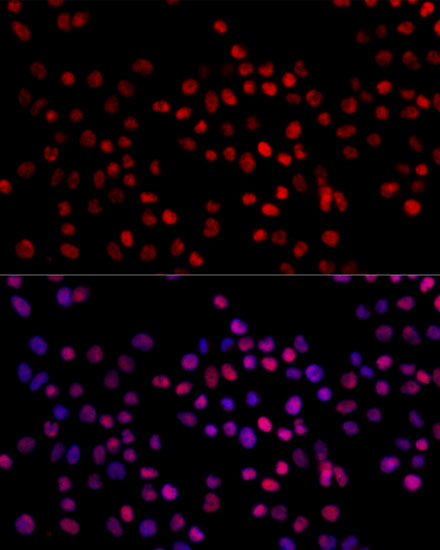Anti-XRCC4 Antibody (CAB1677)
- SKU:
- CAB1677
- Product type:
- Antibody
- Reactivity:
- Human
- Mouse
- Rat
- Host Species:
- Rabbit
- Isotype:
- IgG
- Antibody Type:
- Polyclonal Antibody
- Research Area:
- Epigenetics and Nuclear Signaling
Description
| Antibody Name: | Anti-XRCC4 Antibody |
| Antibody SKU: | CAB1677 |
| Antibody Size: | 20uL, 50uL, 100uL |
| Application: | WB IHC IF |
| Reactivity: | Human, Mouse, Rat |
| Host Species: | Rabbit |
| Immunogen: | Recombinant fusion protein containing a sequence corresponding to amino acids 1-336 of human XRCC4 (NP_071801.1). |
| Application: | WB IHC IF |
| Recommended Dilution: | WB 1:500 - 1:2000 IHC 1:50 - 1:200 IF 1:10 - 1:100 |
| Reactivity: | Human, Mouse, Rat |
| Positive Samples: | Jurkat, MCF7, K562, HeLa, mouse thymus, mouse heart, rat thymus, rat heart |
| Immunogen: | Recombinant fusion protein containing a sequence corresponding to amino acids 1-336 of human XRCC4 (NP_071801.1). |
| Purification Method: | Affinity purification |
| Storage Buffer: | Store at -20°C. Avoid freeze / thaw cycles. Buffer: PBS with 0.02% sodium azide, 50% glycerol, pH7.3. |
| Isotype: | IgG |
| Sequence: | MERK ISRI HLVS EPSI THFL QVSW EKTL ESGF VITL TDGH SAWT GTVS ESEI SQEA DDMA MEKG KYVG ELRK ALLS GAGP ADVY TFNF SKES CYFF FEKN LKDV SFRL GSFN LEKV ENPA EVIR ELIC YCLD TIAE NQAK NEHL QKEN ERLL RDWN DVQG RFEK CVSA KEAL ETDL YKRF ILVL NEKK TKIR SLHN KLLN AAQE REKD IKQE GETA ICSE MTAD RDPV YDES TDEE SENQ TDLS GLAS AAVS KDDS IISS LDVT DIAP SRKR RQRM QRNL GTEP KMAP QENQ LQEK ENSR PDSS LPET SKKE HISA ENMS LETL RNSS PEDL FDEI |
| Gene ID: | 7518 |
| Uniprot: | Q13426 |
| Cellular Location: | Nucleus |
| Calculated MW: | 35kDa/38kDa |
| Observed MW: | 55kDa |
| Synonyms: | XRCC4, SSMED |
| Background: | The protein encoded by this gene functions together with DNA ligase IV and the DNA-dependent protein kinase in the repair of DNA double-strand breaks. This protein plays a role in both non-homologous end joining and the completion of V(D)J recombination. Mutations in this gene can cause short stature, microcephaly, and endocrine dysfunction (SSMED). Alternative splicing generates several transcript variants. |
| UniProt Protein Function: | XRCC4: Involved in DNA non-homologous end joining (NHEJ) required for double-strand break repair and V(D)J recombination. Binds to DNA and to DNA ligase IV (LIG4). The LIG4-XRCC4 complex is responsible for the NHEJ ligation step, and XRCC4 enhances the joining activity of LIG4. Binding of the LIG4-XRCC4 complex to DNA ends is dependent on the assembly of the DNA-dependent protein kinase complex DNA-PK to these DNA ends. Homodimer and homotetramer in solution. The homodimer associates with LIG4, and the LIG4-XRCC4 complex associates in a DNA-dependent manner with the DNA-PK complex formed by the Ku p70/p86 dimer (XRCC6/XRCC5) and PRKDC. Seems to interact directly with PRKDC but not with the Ku p70/86 dimer. Interacts with XLF/Cernunnos. Interacts with APTX and APLF. Widely expressed. Belongs to the XRCC4 family. 3 isoforms of the human protein are produced by alternative splicing. |
| UniProt Protein Details: | Protein type:DNA repair, damage Chromosomal Location of Human Ortholog: 5q14.2 Cellular Component: nucleoplasm; DNA ligase IV complex; centrosome; condensed chromosome; DNA-dependent protein kinase complex; cytosol; nucleus; cell junction Molecular Function:protein C-terminus binding; protein binding; DNA binding; ligase activity Biological Process: pro-B cell differentiation; positive regulation of neurogenesis; central nervous system development; viral reproduction; immunoglobulin V(D)J recombination; in utero embryonic development; isotype switching; T cell differentiation in the thymus; DNA repair; double-strand break repair via nonhomologous end joining; positive regulation of fibroblast proliferation; double-strand break repair; response to gamma radiation; DNA ligation during DNA repair; negative regulation of neuron apoptosis; positive regulation of ligase activity; response to X-ray Disease: Short Stature, Microcephaly, And Endocrine Dysfunction |
| NCBI Summary: | The protein encoded by this gene functions together with DNA ligase IV and the DNA-dependent protein kinase in the repair of DNA double-strand break by non-homologous end joining and the completion of V(D)J recombination events. The non-homologous end-joining pathway is required both for normal development and for suppression of tumors. This gene functionally complements XR-1 Chinese hamster ovary cell mutant, which is impaired in DNA double-strand breaks produced by ionizing radiation and restriction enzymes. Alternative transcription initiation and alternative splicing generates several transcript variants. [provided by RefSeq, Sep 2008] |
| UniProt Code: | Q13426 |
| NCBI GenInfo Identifier: | 44888352 |
| NCBI Gene ID: | 7518 |
| NCBI Accession: | Q13426.2 |
| UniProt Secondary Accession: | Q13426,Q9BS72, Q9UP94, A8K3X4, |
| UniProt Related Accession: | Q13426 |
| Molecular Weight: | 336 |
| NCBI Full Name: | DNA repair protein XRCC4 |
| NCBI Synonym Full Names: | X-ray repair complementing defective repair in Chinese hamster cells 4 |
| NCBI Official Symbol: | XRCC4 |
| NCBI Protein Information: | DNA repair protein XRCC4; X-ray repair cross-complementing protein 4; X-ray repair, complementing defective, repair in Chinese hamster |
| UniProt Protein Name: | DNA repair protein XRCC4 |
| UniProt Synonym Protein Names: | X-ray repair cross-complementing protein 4 |
| Protein Family: | Xrcc4-like factor |
| UniProt Gene Name: | XRCC4 |
| UniProt Entry Name: | XRCC4_HUMAN |







![Anti-XRCC4 Antibody (CAB18046)[KO Validated] Anti-XRCC4 Antibody (CAB18046)[KO Validated]](https://cdn11.bigcommerce.com/s-39x6lpnvxv/images/stencil/590x590/products/20929/19129/anti-xrcc4-antibody-cab18046ko-validated__13236__95828.1644252492.jpg?c=1)

